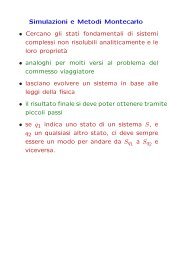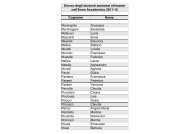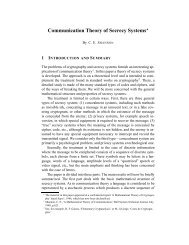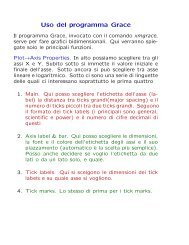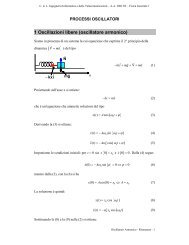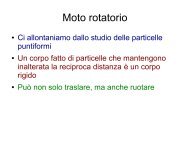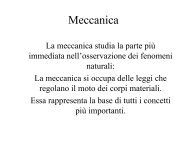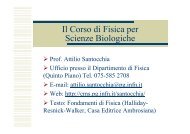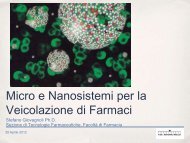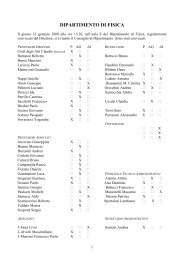PDF (119 KB) - Fisica
PDF (119 KB) - Fisica
PDF (119 KB) - Fisica
You also want an ePaper? Increase the reach of your titles
YUMPU automatically turns print PDFs into web optimized ePapers that Google loves.
Discussion<br />
Comment on ‘‘Decrease in the configurational entropy during a<br />
meltÕs polymerization’’ [Chem. Phys. 305 (2004) 231]<br />
S. Corezzi a,b, *, D. Fioretto b,c , P.A. Rolla d<br />
a Dipartimento di <strong>Fisica</strong>, Università di Roma ‘‘La Sapienza’’, P.le A. Moro 2, I-00185 Roma, Italy<br />
b INFM-CRS Soft, c/o Università di Roma ‘‘La Sapienza’’, P.le A. Moro 2, I-00185 Roma, Italy<br />
c Dipartimento di <strong>Fisica</strong> and INFM, Università di Perugia, Via A. Pascoli, I-06123 Perugia, Italy<br />
d INFM and Dipartimento di <strong>Fisica</strong>, Università di Pisa, Via F. Buonarroti 2, I-56127 Pisa, Italy<br />
In a recent paper, Johari [1] examines the manner in<br />
which, in a paper published by us [2], the reduction in configurational<br />
entropy during a meltÕs polymerization was<br />
connected to the number of chemical bonds, and a relationship<br />
that links the relaxation time to the advancement of<br />
reaction was derived. The author claims to have demonstrated<br />
that the connection we made is untenable on experimental<br />
grounds. He also suggests that the apparent success<br />
in fitting the relaxation time data may just be an artifact of<br />
an improper use of the Adam–Gibbs entropy equation [3].<br />
In this Comment, we discuss the main points of the JohariÕs<br />
argument, concerning the validity of our premise and its<br />
use in combination with the Adam–Gibbs equation.<br />
(1) To investigate the existence of a correlation between<br />
the dynamical slowdown during a meltÕs polymerization<br />
and the loss of configurations caused by the formation of<br />
chemical bonds, we have considered a convenient class of<br />
reactions and chosen convenient experimental conditions,<br />
in which such a correlation could be more clearly exposed.<br />
It is important for the following discussion to recall them<br />
here. We have considered step polymerizations where ring<br />
formation is negligible, and focused on slow reactions (i.e.,<br />
low T) to stay in thermodynamic quasi-equilibrium condition.<br />
A pronounced slowdown of the dynamics usually corresponds<br />
to a number-average degree of polymerization xn<br />
between two and few units (
with s 0 approximately independent of both T and a, and<br />
B =[C/TSc(0)] only dependent on temperature, on the<br />
assumption that the variation of C with a is negligible –<br />
i.e., the relaxation time data vs a should lie on a Vogel–Fulcher-like<br />
curve that extrapolates to infinity at a = a0. Contrary<br />
to what is done by Johari [1], the consequences of Eq.<br />
(1) should be analyzed within the physical conditions that<br />
allow this relation to hold valid. In particular, a tendency<br />
of S c to zero (i.e., of s to diverge) at a finite a 0, as extrapolated<br />
from data at a < a0, does not imply a true vanishing<br />
of Sc (i.e., a divergence of s) ata0. The reaction, in fact, is<br />
not prevented from departing from Eq. (1) and from proceeding<br />
to an extent greater than a0, if the conditions for<br />
Eq. (1) are progressively removed. As a matter of fact<br />
any polymerization can be brought to its full extent by progressively<br />
increasing the reaction temperature, and this is<br />
normally used to estimate the total heat of reaction via calorimetry.<br />
It is also possible when the reaction temperature<br />
is high that the system remains fluid at even full reaction, as<br />
recognized in [1].<br />
While data at a close to or higher than a0 are of no use<br />
for testing a correlation between Sc and s through a test of<br />
Eq. (2), a large amount of relaxation time data in the expected<br />
range of validity of Eq. (1) have been analyzed,<br />
from which an excellent agreement with Eq. (2) has turned<br />
out with the parameter a0 predicted on a molecular basis<br />
[2,6,7]. The observation that this relationship applies to a<br />
wide range of systems investigated, in different conditions,<br />
using different experimental methods, by numerous authors<br />
is hard to be seen as coincidental. Instead, it strongly suggests<br />
that the essence of the relaxational slowdown on polymerization<br />
can be traced back to a bond-controlled<br />
reduction in the number of configurations available to<br />
the system.<br />
Further experiments by our group – in which the characteristics<br />
of the systems investigated and the experimental<br />
conditions have been chosen to meet the requirements for<br />
Eq. (2), mentioned above – have strengthened the basis<br />
for Eq. (1) in combination with the Adam–Gibbs relation,<br />
particularly persuasive being the results for a number of<br />
epoxy–amine mixtures composed of two reagents (DGE-<br />
BA–DETA) in different molar ratios [8]. Because a0 may<br />
be controlled by varying the molar ratio of reagents in<br />
the initial mixture (solid line in Fig. 1), according to Eq.<br />
(2) the extent of reaction at which the relaxation time<br />
behavior appears to diverge would also be varied in the<br />
same way. We have found, for each reaction carried out<br />
isothermally, that Eq. (2) represents the relaxation time<br />
data well, in a wide relaxation range (at least five decades<br />
for s >10 4 s), where xn(a) is few units [8]. The derived values<br />
for the fitting parameter a0 are reported in Fig. 1. Indeed,<br />
Fig. 1 reveals that a0 not only changes with the<br />
mixture composition but (within the experimental error)<br />
actually follows the expected variation with the molar ratio<br />
(N a/N e) of the reacting molecules, in a wide N a/N e range.<br />
Moreover, the same a 0 is obtained by reacting a given mixture<br />
at different temperatures [9], despite the time-depen-<br />
S. Corezzi et al. / Chemical Physics 323 (2006) 622–624 623<br />
α 0<br />
1.0<br />
0.9<br />
0.8<br />
0.7<br />
0.6<br />
10:3<br />
5:2<br />
5:2.8<br />
10:9<br />
0.2 0.3 0.4 0.5 0.6<br />
Na /Ne 0.7 0.8 0.9 1.0<br />
Fig. 1. Variation of the parameter a 0 with the molar ratio N a/N e between<br />
the amino and the epoxy monomer constituents of the system DGEBA–<br />
DETA Ne:Na. The experimental points for different compositions are<br />
labelled by their Ne:Na values. Open symbols are used to distinguish a<br />
different reaction temperature. The solid line is a 0 =[1+(N a/N e)]/2,<br />
calculated from the functionality and the molar ratio of the reacting<br />
molecules.<br />
dent evolution of the reaction is greatly affected. This is<br />
shown in Fig. 1 by closed and open symbols. In the same<br />
figure, isoabscissa closed-points refer to reactions repeated<br />
at the same temperature to check reproducibility.<br />
(2) A number of other observations reported by Johari<br />
deserve our comment. It is asserted in [1] that a connection<br />
between the relaxation time and a by using the Adam–<br />
Gibbs equation can be made only by allowing Dl, and<br />
therefore, the quantity B / Dl to change with a, being<br />
Dl a free-energy barrier per cooperative unit. We notice<br />
that this is the opposite of what the same author maintained<br />
in previous studies of polymerization [10–12]. Apart<br />
from this contradiction, we observe that as long as multimers<br />
behave effectively like cooperative units a variation<br />
of Dl with a seems not to be required by the theory [3].<br />
On the other hand, if one would be forcing Eq. (2) with<br />
wrong but constant values of B, to fit the experimental data<br />
for polymerizations with Dl strongly varying with a, the<br />
values a0 which describe the data could scarcely correspond<br />
to the values of a physical quantity, i.e., the molecular<br />
parameter a0 calculated from the functionality of the reagents.<br />
This suggests that a sensible variation of Dl with<br />
a is not required either by the experimental data. A minor<br />
variation can, of course, account for details.<br />
Moreover, it is asserted in [1] that s 0 in Eq. (2) should<br />
necessarily correspond to the time scale of phonons, i.e.,<br />
10 13 –10 14 s. There is no question that in simple glassforming<br />
liquids analyses using the Adam–Gibbs approach<br />
usually do give pre-exponents not too far from the phonon<br />
time scale, though the values obtained notoriously span<br />
several decades (e.g., from 10 10.5 to 10 17.3 sin[14]). We<br />
remark that for it to be a general expectation the pre-exponent<br />
s 0 should represent the true value of s in the limit<br />
T !1, and different spectroscopic techniques (such as<br />
dielectric and photon-correlation spectroscopy) should<br />
measure the same s. Neither of these is the case. It is<br />
4:3
624 S. Corezzi et al. / Chemical Physics 323 (2006) 622–624<br />
well-known that relaxation times measured by different<br />
techniques all sensitive to structural dynamics may even<br />
differ by a few decades, which obviously reflects in different<br />
values of s0. It is also well-known that at some intermediate<br />
temperature on heating above Tg, the relaxation mechanism<br />
becomes different from cooperative transitions governed<br />
by the configurational entropy, and a marked<br />
change in the dynamics is observed [13]. Because of this<br />
change the relaxation time of a liquid at high temperature,<br />
which actually corresponds to the phonon time scale, may<br />
differ from s0 in Eq. (2), which is the value extrapolated<br />
from the cooperative regime. The difference between the<br />
two could be less pronounced if the process under analysis<br />
is a simple physical process. However, if it is a chemical<br />
process like polymerization then chemical step activation<br />
entropies could become involved and then all bets should<br />
be off about the value of the pre-exponent s 0.<br />
(3) In [1], the author reports as a feature of Eq. (1) that<br />
‘‘... CP, c of a polymerizing melt at a fixed T would not<br />
change as a increases from zero to one’’, and similarly,<br />
‘‘... the product bcVc, [where bc and Vc are the configurational<br />
contribution to the thermal expansion coefficient<br />
and the volume of the melt] would not change’’. On the contrary,<br />
we note that Eq. (1) yields a factor in C P, c and b c V c<br />
explicitly dependent on a [e.g., C P, c(a) =T(oS c(0)/oT) P<br />
(1 a/a0) =CP, c(0)(1 a/a0)], which factor has been erroneously<br />
omitted in [1]. Therefore, our Sc(a) relation does<br />
not conflict with the observation that changes in CP, b,<br />
and V during a meltÕs polymerization are also to be ascribed<br />
to changes in the configurational contribution to<br />
these quantities.<br />
(4) In our opinion, the calculations of S c performed by<br />
Wang and Johari [15] in a lattice–hole model are interesting<br />
but cannot prevail over the indications coming from experiments,<br />
as we have described. In addition, we observe that<br />
Sc, calculated with plausible values of the adjustable<br />
parameters, in the Wang and JohariÕs model would be<br />
expected to initially increase and then decrease with a in<br />
such a way that the value at the full extent of polymerization<br />
is nearly the same as (or even higher than) in the<br />
monomeric liquid (see Fig. 2 in [15]). This result can hardly<br />
be reconciled with an entropy-based picture of the process<br />
of polymerization; which picture, instead, Johari upholds.<br />
On the other hand, different lattice models exist and provide<br />
different results for the statistics of polymer chains.<br />
Interestingly, in a Flory–Huggins model of equilibrium<br />
polymerization [16] the average length of polymer chains<br />
scales inversely with the excess entropy of the polymer<br />
solution, similarly to our premise Sc / 1/xn.<br />
In conclusion, we believe there are sufficient experimental<br />
indications that Eq. (2) captures the principal physics<br />
behind the dynamical slowdown that occurs in a wide class<br />
of polymerizations, and therefore, goes beyond a mere phenomenological<br />
description of the process. We stress once<br />
more that it is appropriate in a limited range of a and T<br />
but this range usually covers the most part of relaxation<br />
data from experiments.<br />
Acknowledgement<br />
S.C. acknowledges financial support from MIUR-<br />
FIRB.<br />
References<br />
[1] G.P. Johari, Chem. Phys. 305 (2004) 231.<br />
[2] S. Corezzi, D. Fioretto, P. Rolla, Nature 420 (2002) 653.<br />
[3] G. Adam, J.H. Gibbs, J. Chem. Phys. 43 (1965) 139.<br />
[4] xn represents the average number of monomers per molecule in the<br />
system. a, also called the chemical conversion, provides a measure of<br />
the extent of reaction.<br />
[5] High temperature also tends: (i) to favor cyclization, which changes<br />
the variation of xn with a (e.g., xn would grow less rapidly and tend to<br />
diverge at a > a 0), and (ii) to favor departure from the quasiequilibrium<br />
condition.<br />
[6] S. Corezzi, L. Comez, D. Fioretto, J. Non-Cryst. Solids 345–346<br />
(2004) 537.<br />
[7] S. Corezzi, AIP Conf. Proc. 708 (2004) 604.<br />
[8] S. Corezzi, D. Fioretto, J.M. Kenny, Phys. Rev. Lett. 94 (2005)<br />
065702.<br />
[9] For all the polymerizations studied, the temperature was near the<br />
onset of the exothermic release in a calorimetric scan at the heating<br />
rate of 10 °C/min.<br />
[10] G.P. Johari, C. Ferrari, G. Salvetti, E. Tombari, Phys. Chem. Chem.<br />
Phys. 1 (1999) 2997.<br />
[11] E. Tombari, C. Ferrari, G. Salvetti, G.P. Johari, J. Phys. Condens.<br />
Matter 9 (1997) 7017.<br />
[12] C. Ferrari, E. Tombari, G. Salvetti, G.P. Johari, J. Chem. Phys. 110<br />
(1999) 10599.<br />
[13] F. Stickel, E.W. Fischer, R. Richert, J. Chem. Phys. 104 (1996) 2043.<br />
[14] R. Richert, C.A. Angell, J. Chem. Phys. 108 (1998) 9016.<br />
[15] J. Wang, G.P. Johari, J. Chem. Phys. 116 (2002) 2310.<br />
[16] J. Dudowicz, K.F. Freed, J.F. Douglas, J. Chem. Phys. 111 (1999)<br />
7116.



